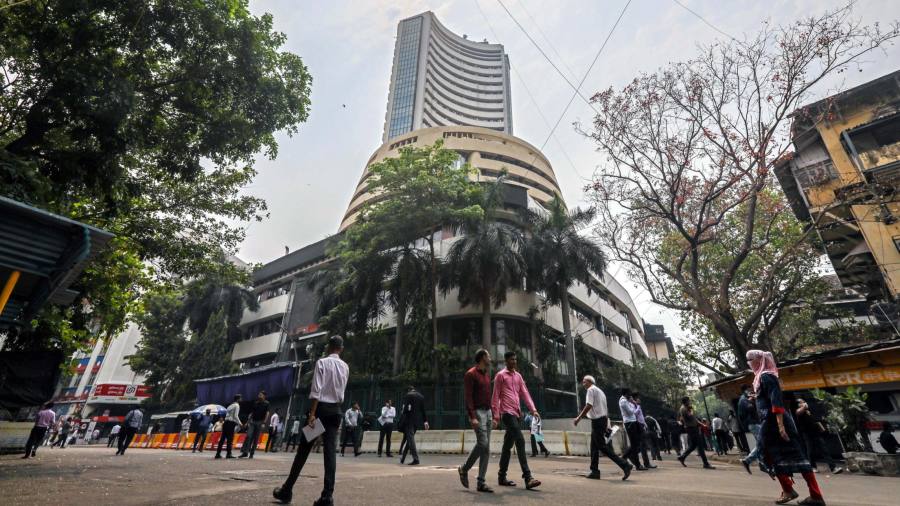The overall value of India’s stock market has surged more than 14 per cent in the past three months as foreign investors buy into the robust economic growth of the world’s most populous country.
The $440bn increase in the value of Indian equities to more than $3.5tn means India has climbed well above both France and the UK to regain the status of the world’s fifth-largest stock market after the US, China, Japan and Hong Kong.
The Sensex index, which tracks India’s 30 biggest companies by market capitalisation and is weighted towards financial stocks, has been climbing steadily for the past three months and hit a record 63,588 points on Wednesday, spurred by buying from foreign pension and insurance funds.
“Foreign institutional investors are playing the role of the catalyst in the current rally,” said Vijay Chandok, managing director of Mumbai-based ICICI Securities.
India’s stock market value surpassed that of France in early 2022 but suffered a sharp sell-off at the start of this year that briefly left it trailing both the French and UK markets.
Indian equities now account for about 3.3 per cent of global stock market capitalisation, according to Bloomberg data.
India’s prime minister Narendra Modi, who is in the US on a state visit this week, has been promoting India as an investment destination and alternative manufacturing base to China.
The gains for Indian shares follow a short-seller attack on the ports-to-power Adani Group in January that wiped about $145bn off the market capitalisation of its seven listed companies. The Adani company stocks, which are not included in the Sensex index, have since rebounded but are still generally below their pre-January levels.
India’s robust recovery from the coronavirus pandemic contrasts with the performance of many Asian peers and growing investor concern about the economic health of China, which India surpassed as the world’s most populous country this year.
The IMF estimates India’s economic growth for 2023 will be 5.9 per cent, compared to 5.2 per cent in China and 1.6 per cent in the US.
Some analysts warn that companies risk becoming overpriced as their share prices climb faster than their profits, sending price-to-earnings ratios soaring. The India-listed subsidiary of consumer goods group Nestlé, for example, is trading at a 12-month forward price-to-earnings multiple of 68, up from 51 in 2019 and more than triple the ratio of its parent company.
Analysts at Mumbai-based brokerage Kotak Institutional Equities this week warned investors that “rich valuations of most stocks in the consumption and investment sectors would logically suggest an unfavourable reward-risk balance”.
But some investors argue these high valuations are a price worth paying for a shot at the growth that is lacking in other markets.
“Valuations might be stretched but they could stay that way for a long time if India is the only economy that is so clearly expansionary,” said Alice Wang, Asia ex-Japan portfolio manager at Quaero Capital in London.
Samiran Chakraborty, chief India economist at Citigroup, said most investors had been “positively surprised by the recent growth momentum of the economy” and were “holding on to their long India positions despite rich valuations”.
Billionaire tycoon Mukesh Ambani’s Reliance Industries — India’s biggest company by market valuation — has risen 10 per cent this quarter after losing ground at the start of the year.
Stocks linked to construction have done well, too, as India embarks on a national infrastructure push. Mumbai paints group Asian Paints has gained 20 per cent in the past month, while Tata Steel is up 9 per cent.
Indian shares have received $9.4bn of net inflows from foreign portfolio investment in the second quarter, according to Bloomberg data. The Kotak Institutional Equities analysts said “the bulk” of the net inflow this year had been passive, meaning fund managers were buying a whole index rather than choosing specific stocks.
Nilesh Shah, managing director of Kotak Mutual Fund, said that while corporate governance was improving at Indian companies, it was still risky to invest in the whole market as a “top down” passive investor.
“Undoubtedly there is a set of global investors who are just buying top down,” said Shah. But in a stock market, “there are good apples and bad apples . . . you can’t come top down in a country like India”.
Read the full article here



